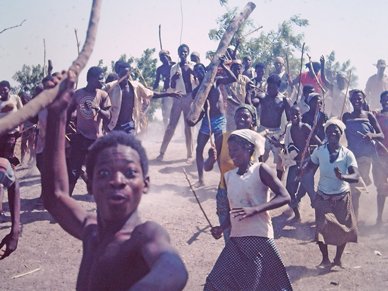
Franz Kröger
Religious and Rebellious Elements in Bulsa Funeral Rituals
Note: All the photos, if not stated otherwise, were taken by
the author. Other sources: M.S. = Martin Striewisch (Essen), D.L. (Danlardy
Leander, Wiaga).
 |
Although the Bulsa are often regarded as one of the best-studied ethnic groups
in Northern Ghana, their funeral rituals, with their interweaving of innumerable
religious rites and secular acts of various kinds, have never been the subject
of a general monographic publication1.
In the following investigation, I have limited myself mainly to religious rites and to those in
which a rebellion against the existing order is expressed, including those rituals that subvert
both traditional values and social roles and break hitherto strictly-observed taboos very
openly.
1. Fate of the deceased person's soul (chiik)
The basic religious idea of funeral celebrations may lie in preparing a transition of the
deceased from the land of the living to the land of the dead. In order to understand this
process better, it is necessary to clarify which parts of the human personality are affected by
certain rites concerning the deceased. The Bulsa attribute a number of personality
components to each person.
One of them is nyuvuri (cf. nyueri, 'nose', and 'vuum' life) or the "pulsating life", which is
mainly revealed in the respiratory movements. Another component is the "life force" or
pagrim, which is not only shown in physical strength but also in the immunity from and
resistance against harmful spiritual influences, e.g. ghosts, witches, bush-sprites, etc. (cf.
Kröger 1978: 143-145). The personality components mentioned so far play only a
subordinate role in burial and funeral rituals. More importantly, there are the functions and
activities of the following three components (ibid. 140-143):
• The body (nying, pl. nyingsa)
• The wen, a divine power associated with an individual but worshipped by sacrifices to a
shrine outside the body (Kröger 1982: 6ff and 2003: 254ff)
• The soul (chiik, pl. chiisa)
The body and its odour (piisim) may be a great danger to the living. Only the initiated grave
diggers know exactly how to deal with it.
The corpse of a deceased is usually buried on the day of death. This activity usually takes
place within the narrow circle of one's own family and with only a few rituals.
The veneration of a deceased person's wen is intensified only years or decades after the
burial. Although during the funeral celebration the wen-shrines of the deceased exist in the
compound, sacrifices to these or any other rituals are not a part of the funeral celebration.
As will be explained in more detail below, the soul (chiik) of the dead is paramount among
the religious events of the first funeral celebration. After the funeral, the personality of the
dead man is represented less by the tomb than by the sleeping mat (tiak, rolled: ta-pili) on
which the dead man died, for it
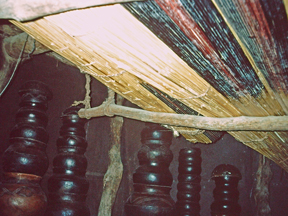 |
|
Dead mats under the ceiling of a room |
is regarded as the abode of his
soul2. Shortly before or after
the burial, a neck rest (zukpaglik) consisting of part of a branch is rolled up into the mat and
laid under the deceased's neck before the burial. After this, the noai boka ritual is performed,
and with the aid of the mat, the person guilty of the deceased’s death is determined3. In the
following ta-pili yika ritual, two gravediggers hang the mat under the ceiling of the dalong
(kpilima dok, ancestral room), where it remains until the first funeral.
To a great extent, the soul of the dead, which is in or near the mat, represents the personality
of the deceased, and any contact takes place by way of the mat. For example, in the past this
entailed leaving a small dish of food in the ancestral room every evening and, on the next
morning, removing the untouched food. This means that the dead man did not consume the
food in a material sense but only took its power to provide nourishment. Afterwards it was
consumed by humans or fed to animals. Furthermore, certain preferences of the deceased like
the enjoyment of beer, kola nuts or tobacco are respected by placing these luxuries for some
time in the ancestral room.
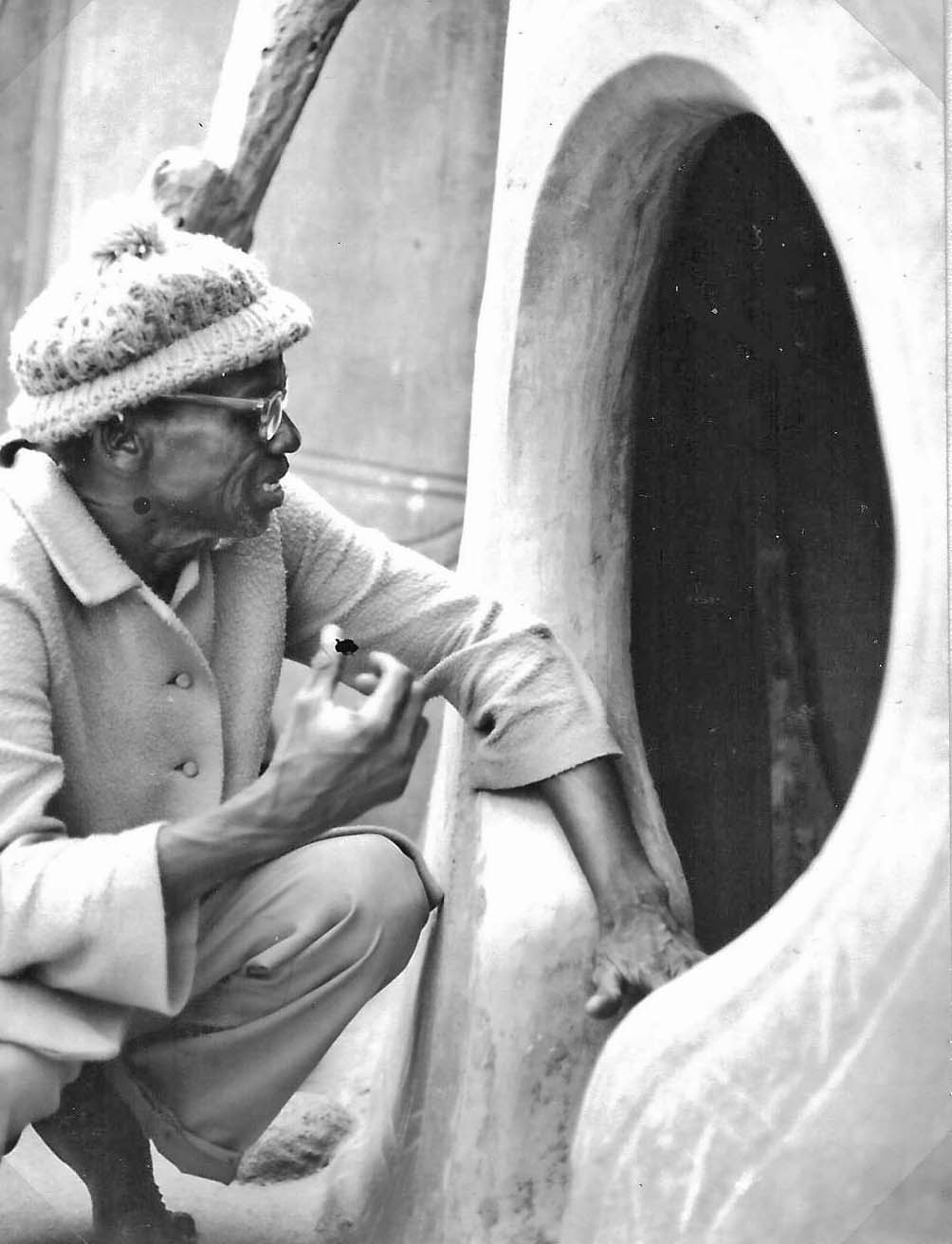 |
|
The acting compound head speaking to his predecessor's soul |
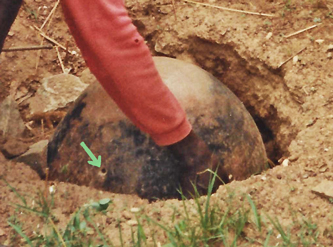 |
|
The hole in the tomb (see arrow) |
The soul of the dead is not always enclosed in the mat or hovering around it. It can, for example, visit the deceased's body in the grave (boosuk). In order to have free access, a small hole is left in the ceramic cover of the grave until the end of the Juka celebration. According to information from Gbedema, some Bulsa (usually thoughtlessly) invite the ancestors or the dead to eat with them by uttering the following sentence before eating: Ni de abe ni ge te mu (You eat before you give me). Also, a ceramic pot (liik) with drinking water located in a corner of each courtyard should never be empty so that recently deceased persons and ancestors can serve themselves here.
When the head of a compound (yeri-nyono) dies, it is either his eldest brother or his eldest son who is responsible for his soul (see below). However, they exercise this office only for the deceased and must inform their predecessor about every important
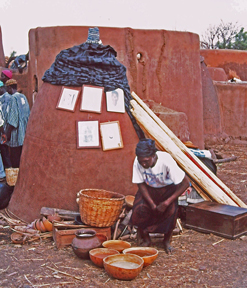 |
|
The dressed gain store |
ritual in the compound by speaking to his soul in the mat.
At the first funeral celebration (Kumsa), the mats are of extraordinary importance. On the first day, they are taken from the ancestral room to the courtyard (dabiak) of the compound head's eldest wife (Ama). Here they are rubbed with cloths and a horse tail. One chicken or cock is killed for each mat by beating the animal's head on the ground and throwing it on the ash-heap
(tampoi). This killing is part of the nang foba ritual, which is later supplemented by
the bloodless killing of mammals. According to one source, the bloodless killing will enable
the ancestors to begin poultry or cattle-breeding with these animals in the land of the dead.
The death-mat is carried to the central millet store of the compound and is located in the
middle of the cattle yard. The mat as well as the grain store (bui), clothed with the garment
(garuk) and the hat (zutok) of the deceased, are visited first by newly arriving guests to greet
the deceased here and mourn his death. (photo)
In the evening of the second day (Tika Dai) of the Kumsa-funeral, grave diggers burn the mat
together with the
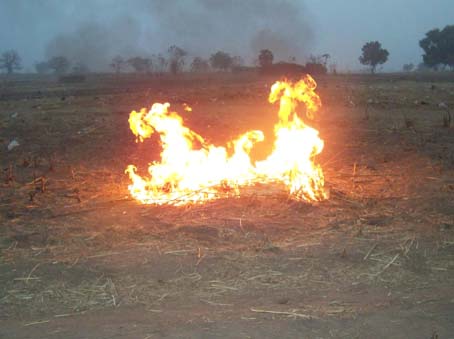 |
|
Burning the mat |
zukpaglik neck support in a free field outside of the farm.
These rituals make it appear as if a series of actions concerning the mat and the soul enclosed
in it have come to an end, since, by burning the mat, the soul is released in a certain respect.
However, it does not immediately enter the land of the dead (kpiluk). This event takes place
only at the second funeral (Juka) when the soul of a deceased male stays
with his quiver and
bow or the soul of a woman with a number of certain ceramic pots. It is only when the quiver
and bow are destroyed and burnt in the juka-ritual or the ceramic and calabash vessels of the
women are broken [see below], that the soul of the dead can enter the land of the dead. These
rituals of destruction evoke strong emotional outbursts of close relatives because, as a woman
told me, "only now have we finally lost our relatives".
|
|
|
|
| A grave digger is
chopping the bow and
quiver into small parts |
The bow and quiver are burned | Ceramic vessels
and calabash
bowls are destroyed |
2. Funerals and rites of passage
Among the Bulsa and many other African ethnic groups, religious events must be studied
with the societal context in mind and social activities must be studied with the religious
aspects in mind. After the death of an elderly person, profound changes take place in his
immediate and wider social environment. When an office such as that of a compound head
(yeri-nyono) or of a lineage-elder (kpagi) loses its owner, the deceased themselves assume
the status of ancestors (kpilima) after some time. The positions of the family members are
also changed: wives (pooba) of the dead take on the widow status (pokongta), and his
children (bisa) are called orphans (bi-kpingsa). The man of greatest seniority in the list of
candidates for his office - it may be his eldest son or the oldest surviving brother of the
deceased - assumes the responsibilities of the departed office-holder, while all other
candidates on the "waiting list" move one rank or position up the ladder (cf. Kröger 1978 and 2003).
However, these changes do not take place immediately after the deceased's death; rather, a
long transitional period is required. This transition may be visible in, among other things, the ritual course of the funeral celebrations. The French ethnologist Arnold van Gennep (1873-1957) examined these transitional rites (rites de passage) and distinguishes three phases:
...I have tried to assemble here all the ceremonial patterns which accompany a passage from one situation to another or from one cosmic or social world to another. Because of the importance of these transitions, I think it legitimate to single out rites of passage as a special category, which under further analysis may be subdivided into rites of separation, transition rites, and rites of incorporation (1960: 10f.).
(The original French text reads)
...j'ai tenté de grouper toute les séquences cérémonielles qui accompagnent le passage d'une situation à une autre et d'un monde (cosmique ou social) à un autre. Étant donée l'importance de ces passages, je crois légitime de distinguer une catégorie spéciale de Rites de Passage, lesquels se décomposent à l'analyse en Rites de séparation, Rites de marge et Rites d'agrégation (1981a: 13-14).
1. Separation rites (rites de séparation)
In this first phase, the ritual participants – in our case the deceased and the deceased’s close
relatives – abandon their old state which existed before the death. They receive markings
typical for second phase actors and these include hair shaving, body painting, wearing special
clothes, etc. Often a local separation from the old environment also occurs.
2. Threshold and transformation rites (rites de marge, rites liminaire)
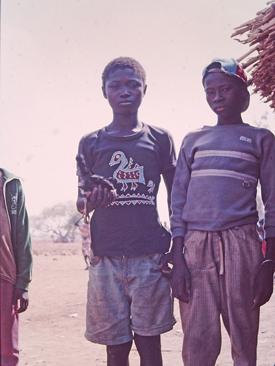 |
|
Two boys receive a chicken for their divination |
In the second phase, which encompasses the transition between two states, old roles of
gender, social position and age are abandoned or transformed into their opposites. For
example, a young woman may wear the clothes of her old, deceased father-in-law or children
may play the roles of adults by practising the activities of a soothsayer. Groups with a
subordinate role (e.g., children and adolescents) in the pre-death society rebel against the
gerontocratic classes of the old system through transgressions of various kinds (e.g. theft) or
may even demonstrate an openly aggressive or rebellious attitude.
3. Incorporation rites (rites d'agrégation, rites post-liminaire)
In the third phase, the ritual subject receives a new social identity and is re-integrated into
society with a new status. New ties and commitments must be adopted.
At Bulsa funeral ceremonies, all three phases appear, though not in a strictly chronological
sequence. Rather, we must follow the three phases in coherent strands of action that
sometimes begin immediately after the death of the close relative and cease at the end of the
last funeral. Such a sequence will be presented here for ritual actions, such as they are
performed on widows of the deceased person.
3. The widows and children of the dead as ritual subjects
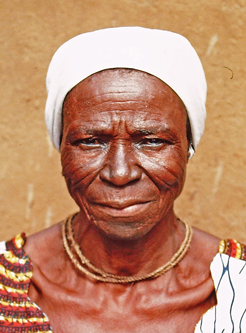 |
|
Strings around a widow's neck |
After the burial of a married man, rites are carried out on his widows, which, according to
van Gennep, are to be described as "rites of separation". The special status of these women is
characterized by a change in their external appearance.
A certain woman (jom-suiroa) is responsible for carrying out the rituals, called jom-suka.
After the heads of the widows have been shaved4, (in
Wiaga) the jom-suiroa5 puts braided or
twisted strings6 around the widows' necks and around their waists. Often a first bath is
connected with this ritual. The strings identify the widows as such and also emphasize their
still-close connection to their dead spouses. Therefore they should not remove them until
their remarriage. This, however, is no longer observed today.
With the jom-suka ritual, the widows enter the second of van Gennep's phase. This
"transitional period" ought to be characterized by grief and a retired
life. During the first
days of the Kumsa funeral, all the widows retreat to certain quarters of the mourning house
and hardly appear in public over the
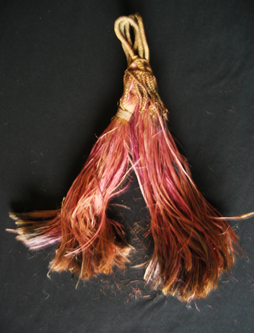 |
|
Red-coloured fibre tufts |
course of the ritual events during the festivities. In former times, their clothing would have consisted only of red-coloured fibre tufts, and today these are still worn above or below their clothes. On the 2nd day (Tika Dai), on the evening of the third day (Kpaata Dai) or (less frequently) on the 4th day (Gbanta Dai) of the Kumsa celebration, all widows are led out of the compound through the main entrance to be ritually bathed. The accompanying women form a narrow circle around the widows to protect them from prying eyes. According to one source, the widows are anointed thickly with shea butter, perhaps for protection from the hot water, and then bathed by the jom-suiroa woman, who pours boiling-hot water7 over their backs. If burns occur, this means that the concerned woman was not faithful to her husband (especially after his death).
The question arises as to why the widows leave their courtyard in the interior of the
compound (where they could have carried out the bathing ritual undisturbed and protected by
walls) and move to a spot in front of the compound where many people might watch them.
Obviously the procession itself is an important ritual8. The entrance to the compound is
generally regarded as the threshold between the private sphere of the compound and the
public free place (pielim) in front of the entrance, which is generally regarded as the domain
of the male inhabitants. Together with the bath itself, the widows' passing through a narrow
gate is a preparatory rite for their reintegration into the public, largely male-dominated world.
The ritual-proper of the reintegration (agrégation) consists of the widows' remarriage, which
is to take place on the third or fourth day of the second funeral celebration (Juka). It is
preceded by another haircut and another bath. All the widows meet in the courtyard of their
deceased husband's mother. One after the other is asked who they want to be their new
husband. The elders, who have met in the kusung-dok (a meeting room in front of the
compound) expect them to marry a close relative of their deceased spouse, but even if they
choose a man from a neighbouring compound that belongs to their late husband's sub-lineage, it will be approved (albeit reluctantly). It is not acceptable for the widow to choose a
man from a foreign lineage. However, in such a case, the widow would leave her former
residence before the remarriage ritual9.
Some, especially older women, prefer to remain unmarried and to live together with their
sons in their former husband's compound. Asked about their preference for a new spouse,
they may answer, "Maa yali n chorowa boosuku" ('I marry my husband's grave').
Alternatively, they can also choose a very young boy as their new fictional husband. When,
however, I once witnessed several widows of a marriageable age (i.e. before menopause)
give such evasive answers, the head of the compound (here the father of the deceased) was
visibly annoyed.
No men participate in the questioning of widows. As soon as one of the women has uttered a name, a messenger woman is sent to the men in the kusung-dok. Usually the men give their consent immediately. After their remarriage, the widows wear their normal clothes again.
Some of the rites practised on the children of the deceased resemble those carried out on the widows, but they are reduced in number and are less pronounced in execution. This may be due to the fact that, although children may be emotionally more affected by the death of their father, their social position is less of a concern. Their new father will be their biological father's oldest brother, for whom they will have always used the term "father" (ko). The change in their social position is limited to the fact that they have advanced by one step in the expectation of their father's office.
On the oldest son, whether he is a direct successor or not, and the youngest son, who is usually the favourite son of his father10, some rites are performed at the funeral which make these boys stand out in the crowd of other mourners. On the second day of the Kumsa celebration, the eldest son eulogizes his father in a speech and he puts on his father's clothes – an act that would have been considered taboo during his father's lifetime. The youngest son has to wear a metal bell on his belt. As an explanation for this, I learned that people always want to keep an eye on him in order to prevent a possible suicide. Near the central grain store, a woman paints all the children of the deceased in the face, on their arms, and often on their chests with red daluk clay in order to mark them as particularly affected. The clay also serves the purpose of preventing the deceased person from recognizing his beloved relatives, whom he desires to take with him into the land of the dead. The closer a person was related to the dead, the more paint is applied to his or her body.
Daughters and sons may wear a nabiin-soruk chain of beads, and daughters and granddaughters wear red caps (see above).
|
|
|
| Paintwork with red daluk clay | Woman wearing
the red cap,
the bead necklace, the boom-band and red paint |
4. The liminal phase in the funeral celebrations of the Bulsa
Most Bulsa funeral rites have a rather 'punctual' character. That is, they introduce a new ritual
or social condition of family members and consist of only 1 to 2 actions. These actions can
include the casting off of old things (e.g. head hair11, body dirt, clothes) acquired in the time
before the relative's death. Rituals of the third phase, such as a common meal and the
remarriage of the widows, re-establish conditions of a permanent order.
The second phase, which starts at the beginning of the first funeral celebration and ends only
at the end of the second, has a longer duration and consists of several single rites.
The ritual subjects of this phase are lifted out of everyday life and lose their former status.
Victor Turner, who studied this phenomenon for other ethnic groups and other rites, puts it
this way:
... during the intervening liminal period, the state of the ritual subject (the "passenger") is ambiguous; he passes through a realm that has few or none of the attributes of the past or coming state ... (p.94)
... They [the ritual subjects] are no longer classified and not yet classified (p.96).
In the Bulsa funeral ceremonies, this affects, for example, the widows of the deceased
because their condition is only temporary: they are neither the wives of the old nor of a new
husband. Also the dead man has neither a status in the realm of the living nor has he attained
his ancestral status.
Associated with the loss of status, other important principles of organization of an established
society are lost or become disordered, including gender roles and attributes (see 4.1),
principles of moral order (prohibition of theft, adultery, see 4.3 and 4.4) or the attitude
toward taboos (see 4.2).
4.1 Changing established gender roles12
While usually the performances of rites and sacrifices is entirely in the hands of the men,
even an uninvolved visitor to a Bulsa funeral discovers that in most ritual activities, the
women play a leading role. On the 1st or 2nd day of the Kumsa celebration, two women carry
the death-mat from the courtyard of the senior wife (Ama-dok) to the grain store in the cattle
yard. There, under the leadership of the jom-suiroa, they perform all rites: painting close
relatives with red clay, attaching fibre bands (boonsa, sing boom) to the left wrists of male
relatives and placing red caps, which are otherwise worn only by chiefs and diviners, on the
heads of the deceased's daughters and granddaughters. During the first funeral celebration,
women beat sinsangula rattles and sing songs in memory of the dead13.
|
|
|
|
| The death-mat is
taken
to the grain store (D.L( |
Sinsangula-women
singing dirges
at the death-mat |
Sinsangula-rattles |
Taking out the death-mats on the second day of the Kumsa celebration is also carried out only by women, although
two male gravediggers burn the mat. Women also take part in "storming" the ash-heap
(tampoi) as described below (4.5).
War-dances and all warlike activities are usually reserved for men. In some funeral
ceremonies, however, women join the male group of war-dancers, or they form their own
group without wearing warriors' costumes and weapons.
If females wish to sacrifice to a shrine in everyday life, they can donate the sacrificial animal
and be present for the sacrifice. However, pouring libations, killing animals and saying
prayers are rites carried out by men only. On the fourth day of the Kumsa celebration, the
very important sacrifices to the outer wall (parik) of the compound are performed by a
woman who smears millet porridge and a bean dish onto the wall. Sacrifices of this kind for a
deceased man take place in front of the zamonguni pillar at the main entrance of the
compound and are carried out for a married woman behind the compound. Before and
after these
sacrifices, a woman runs around the compound three times while beating a cylindrical drum
(ginggaung), an instrument usually beaten only by men.
|
|
 |
| A woman
sacrificing to the wall (parik)
with another woman closing her eyes |
The wall with sacrificial bean-food |
The most obvious manifestation, however, for changed gender roles becomes apparent in the
figure of the cher-liewa (or che-dierowa) or "imitator". In order to draw a picture of the
deceased’s character, the daughter-in-law puts on his clothes at the Kumsa
celebration and imitates him not only by her appearance but also through the
performance of small, dramatic and not always benevolent scenes from the
deceased's life14.
• In Wiaga-Chantiinsa, the imitator continued to quarrel with visitors, which sometimes ended
in a row. The dead man was considered to have been very contentious and had been a party to
many rows during his lifetime.
• In the case of a deceased drinker, the actress staggers through the crowd and tries to imitate
the speech of a drunkard.
• If the deceased was blind in his last years, the imitator taps her way with a stick or is led
through the crowd by a small boy.
• In Sandema-Kalijiisa, I experienced a woman suddenly bursting into loud crying and
announcing that she wanted to return home to her parents because her husband had beaten her.
The imitator, playing the role of the deceased, took care of her, consoled her, and persuaded
her to remain in the compound as he had done during his lifetime with married women in a
similar situation.
• When, at a funeral, the imitator was given cola-nuts – a favourite dish of the deceased – she
buried them immediately in the earth so as to avoid sharing them with others.
|
|
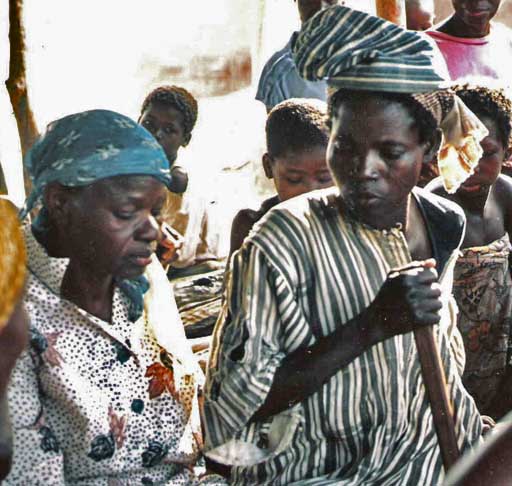 |
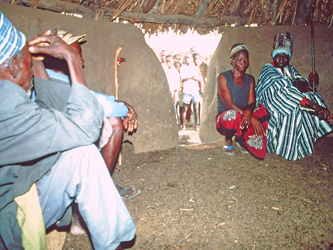 |
| A daughter-in-law
imitating
her blind father-in-law (M.S.) |
The late compound head comforting a weeping woman |
The imitator
visiting the old
men in the kusung-dok (M.S.) |
The audience reacts to successful sketches with laughter, and the mourners forget their grief. They may also take part in the play. For example, they may address the imitator by the name of the deceased. In one case, they asked the "deceased", who had been an eager market visitor while alive, to buy certain things for them at the market.
An imitator can also take over other tasks at a funeral celebration: she sometimes beats the cylinder drum after the parik-kaabka sacrifice or paints close relatives with the red daluk clay. An important ritual consists of her and the sinsangula women visiting the kusung-dok (meeting room), where the old men, the leaders of the whole funeral, have assembled. In Anyenangdu Yeri (Wiaga-Badomsa), the imitator sat down among the old men and asked them, "Why are you here in this room?" They replied, "Anyenangdu died, and we are here to perform his funeral." At the end of a dialogue, the women returned to the central grain store and were given a bottle of Akpeteshi (palm brandy), a pot of millet beer (daam) and two large calabashes with millet water (zom).
4.2 Non-observance of taboos (kisita, sing. kisuk)
The following taboos of normal everyday life are either completely disregarded, entirely
institutionalized or considerably mitigated in their demands during funeral celebrations.
• Dirges are not allowed to be sung outside the funeral celebration.
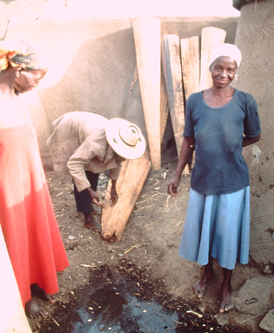 |
|
The rolled up sleeping mats (in the background) standing on the floor with their thin ends on the ground (M.S.) |
• Rolled-up sleeping mats may only be placed on the floor with their thicker ends below. In
the case of funeral ceremonies, this otherwise tabooed method of positioning mats is even
demanded for death-mats in certain rituals.
• In everyday likf you must not jump over a lying mat or step on it. When an animal jumps over it, it is
immediately slaughtered.
• You must not stay in the entrance of a compound.
• It is generally forbidden to put a cloth or dress on the roof of a kusung or kusung-dok, which are the
meeting rooms in front of the compound.
• Women must not kill animals. At the Kumsa celebration, however, a woman is allowed to
strangle a goat or a sheep with her hands or feet.
• Voandzeia subterranea or round beans (suma) and the small ordinary beans (tue) must not
be cooked together in the same cooking pot, as it is done in the ritual on the third day of the
Kumsa celebration.
• The eldest son is normally not allowed to look into his father's grain store while his father is
living
![]() . At the first funeral, he is ordered to do so and henceforth the old taboo is abolished
forever.
. At the first funeral, he is ordered to do so and henceforth the old taboo is abolished
forever.
• Similarly, while a young man may borrow a piece of clothing from his brother, and, as I saw it, a wife may dress in her husband's clothes for fun, the eldest son must never wear a garment of his living father. This taboo is also abolished forever in a ritual taking place during the first funeral celebration.
4.3 Ritual theft without sanctions (chiaka, 'snatching')
Theft is not only regarded as a serious crime among the Bulsa, but some tanggbana (spirits of
earth shrines) have also declared it to be their special taboo. This means that they punish theft,
which is not instantly expiated, with death.
For children of a family there is a certain licence in "procuring" some foodstuffs. There are no hard penalties if, for example, they take some peanuts from a basket for consumption without permission. Picking fruit from trees in small quantities for their own needs is usually allowed. However, severe penalties are to be expected for the theft of meat. In addition to beating the child, any food – at least in the past – could be refused to such a young thief for a whole day. A child’s theft of meat is considered even more severe when they steal the meat from a prepared meal, which is intended for guests or old men.
However, on the 4th day of the Kumsa celebration, this very sort of theft is happening. While women prepare millet porridge (saab, TZ) with meat in front of or behind the compound, a group of boys are already scheming about how they can steal parts of the meat. If they have snatched a piece in an unguarded moment, they immediately consume it at a certain distance from the cooking-place. The cooks can fight against theft and try to expel the boys with sticks, or they form a human shelter by surrounding the cooking-place. However, there is no later punishment for meat theft. I know of a case where the old men (kpaga) had to eat an almost meatless millet porridge in the kusung-dok as a result of the boys' "theft".
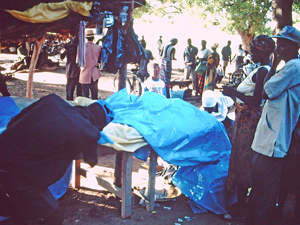 |
|
Wiaga Market: The displays of a market stall are covered with a plastic tarpaulin. |
A similar, ritually-permitted theft on a market square is known to me to have occurred at the
late Wiaga chief's funeral.
On the 3rd day of the Juka celebration, a larger group of the
mourners, accompanied by musicians, moved to the nearby market. Here, some market
women had already cleared their stands prematurely or covered their displays with thick
plastic sheets. A woman showed me a thick stick, which she intended to use against the
children's "robbery". But here, too, the children were able to "steal" all goods without later
punishment.
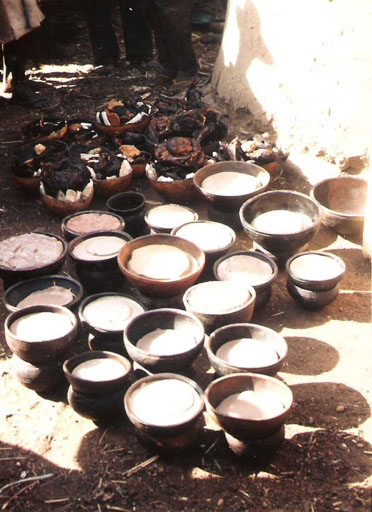 |
|
In front: clay bowls with millet porridge; behind: calabashes with meat and fish |
Not fully institutionalized "impertinence" during the funeral celebration can be criticized, but cannot be prevented with force or even be punished. On the fourth day of the Juka celebration, about 20 ceramic bowls of millet porridge (TZ, saab) and as many calabash bowls with meat and fish were placed in a courtyard of Ajuzong Yeri (Wiaga-Mutuensa) to be distributed to certain guests in a fixed order. Each guest who was called by name could choose a bowl of millet porridge and a calabash with meat or fish according to his taste. When a young man from another section was called, he searched for his favourite dish for a long time, took a bowl with TZ and a calabash with meat and added meat from several other bowls. People criticized his impudence and greed, but he was not to be prevented from carrying out his impertinent action.
4.4 Sexual license
In the descriptions of the 2nd phase in other rites of passage and in other societies, we often
find references to a permitted or even ordered sexual license at great festivals. This often
occurs, for example, among young people following their puberty initiation.
In the Bulsa funeral ceremonies, these phenomena are not very pronounced. In speeches to the
visitors of such a festivity, an old speaker sometimes expresses his desire for all of the
bachelors present to find a partner on this occasion. However, he is probably considering a
later marriage that has been properly carried out according to the Bulsa tradition. (During a
funeral celebration, no wooing rituals may be performed.)
At a Kumsa celebration in Sandema-Kalijiisa-Choabisa in 1973, an old man in his speech announced that marriages between Choabisa and the other
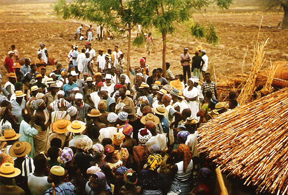 |
|
Speeches at Choabisa funeral |
subsections of Kalijiisa would be allowed in the future. This statement referred to traditional marriages as part of an established order and not to a time-limited licence.
Although no fundamental laws of sexual morality are abolished, some prescriptions are
somewhat relaxed, and sexual transgressions during a funeral celebration are less severely
punished by men and spiritual powers.
The exogamy prohibition to marry within one's own lineage remains, but the initiation of
marital connections with distantly related or matrilineally related lines is often tolerated at
funerals. Adultery, especially between a woman
and a member of her husband's lineage, is
considered an abominable offense and must be atoned for by the kabong-fobka ritual, which is
regarded as shameful for the persons concerned (see Kröger 1978: 285-86). According to one
source, adultery during a funeral celebration between a woman of the mourning house and a
partner who is not part of her husband's family is tolerated, and the adulteress does not even
have to tell her husband about her offense. According to information from Sandema-Kalijiisa,
this license is limited to the third day (Kpaata Dai) of the Kumsa funeral.
4.5 Aggression and open rebellion
The above-described licenses (4.1 - 4.4) are sometimes not perceived as rebellious acts or
reversals of the existing order. In order to recognize violations of taboos as such, the taboo (as
it existed before the funeral celebration) must be known. Otherwise the stealing of meat by
boys could, for example, be simply ascribed to tricks carried out by young scamps of a certain age.
On the third day of the Juka funeral celebration, however, the whole order of the festival
seems to be disturbed by rebellious and aggressive actions. On April 26, 1989, I witnessed the
following in Ajuzong Yeri (Wiaga-Mutuensa):
Immediately after the chopping and burning of the quivers and bows of the deceased, about 50
metres from the entrance to the compound, an excitement and disturbance arose among the
younger participants. A young man pulled a forked post (zangi) out of a shed and ran around
the compound. He was followed by a group of young men and women who were "armed" with
clubs, axes, or forked posts. After surrounding the compound, their aim was the ash-heap
(tampoi) in front of the compound, which was "stormed" with great noise. Certain people were
also the target of an apparent aggression. Once the group approached me shouting loudly but
stopped a few metres in front of me and retreated. It is remarkable that even girls had formed
a kind of war-dance group without the traditional costumes or weapons and participated in the event.
|
|
|
|
Juka-funeral at Wiaga-Mutuensa: Young people are storming the ash-heap. |
|
I was only able to observe this act of rebellion and aggression in Wiaga-Mutuensa. A variation
of a war-dance, which is carried out at the same time in the ritual context of the funeral in
other compounds, has perhaps replaced the very elaborate ritual of Mutuensa. The war dance
variant takes place without war-costumes and - apart from sticks - without weapons, although
it is accompanied by musical instruments. A group of men, most of them elderly, form a row
on the free place (pielim) in front of the compound, and several times they move towards the
tampoi and back again. Whenever the tampoi is reached, the foremost man will leave the row.
This kind of war dance can also be performed on various other days of the Kumsa celebration.
In one observed case, women joined the "warriors".
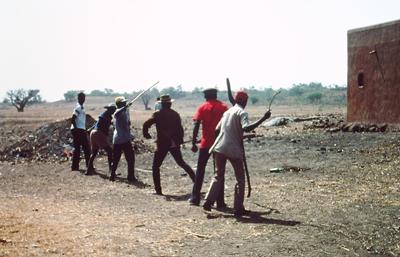 |
|
In a variety of the war-dance men dance to the ash-heap (M.S.) |
In a comparison with rebellious behaviour during liminal phases of other ethnic groups, it is
striking that elsewhere the target object or subject is clearly defined, e.g. the king at a change
of throne. Among the Bulsa, however, there is no clear target person or target group for the
rebellious behaviour. The question arises as to why the tampoi was chosen as the goal of
"aggression" or as the end point of a war dance. A much stronger symbol for the
overpowering position of a deceased compound head, for example, would have been the
central grain-store.
We cannot answer this question clearly but can only present some ideas concerning the
practical, social and religious significance of the tampoi. It is mainly a waste heap, especially
for the hearth-ashes of the households15. Organic household waste is fed to the cattle or finds a
place in the cattle yard, where it is later used, together with the cattle manure, as a fertilizer
for the fields.
The tampoi also serves as a burial site for premature births, for children having died up to the
age of six months and for a woman's placenta after birth. A high tampoi, as one finds it mainly
in front of the chiefs' compounds, is an important prestige object, because it clearly points to
the high age of the compound and the high number of its inhabitants. While the tampoi-ashes
are also used as a fertilizer in smaller farms, large compounds attach importance to a
particularly high heap. When the tampoi has been partially washed down and flattened by
rainfall, the old, high form is sometimes restored with a bulldozer. The various practical as
well as symbolic roles of the tampoi, however, help little to shed light on the significance of
the mentioned rites of the Juka celebration.
5. Problems of doubling funeral celebrations
Funerals performed at a certain time interval after
![]() the burial of a deceased are generally
common in Ghana and other West African countries. However, more rarely do they occur in a
double form. In the case of the Bulsa, this doubling (Kumsa and Juka) makes it difficult to
recognize a clear structure as well as a continuous, consistent course of the entire celebration.
The second funeral does not start where the first has ceased, but several ritual sequences are
repeated in a similar form.
the burial of a deceased are generally
common in Ghana and other West African countries. However, more rarely do they occur in a
double form. In the case of the Bulsa, this doubling (Kumsa and Juka) makes it difficult to
recognize a clear structure as well as a continuous, consistent course of the entire celebration.
The second funeral does not start where the first has ceased, but several ritual sequences are
repeated in a similar form.
As stated above, the religious meaning of a funeral is to transform the dead from his/her
existence in the world of the living into communion with his/her ancestors. This would
already be possible after the death-mat, the previous temporary stay of the soul (chiik), is
burned on the second day of the Kumsa celebration, thus releasing the soul from its material
ties and enabling it to pass into the land of the dead. Rituals relating to the further presence of
the soul in the compound, such as the provision of food in the ancestral room (kpilima dok or
dalong), have since ceased. However, it is not quite clear which material objects the soul is
attached to in this period. A piece of information from Sandema-Kobdem says that it is
probably in the grain store of the dead16, but this assumption has not been confirmed by other
informants. Usually it is believed that it stays somewhere in the ancestors' room (kpilima dok),
where the bows and quivers of a deceased man are also stored.
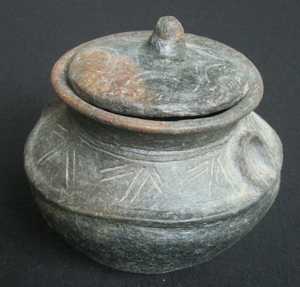 |
|
Kpaam-kabook for storing shea butter |
It is only at the Juka celebration, which often takes place many years after the Kumsa, that the
a dead woman's soul is associated with certain clay vessels (often the
kpaam-kabook) or that a
man's soul is associated with his quiver (lok) and bow (tom). When the pots are destroyed and
the weapons are burned, it is generally assumed that the soul is starting its journey to the land
of the dead. Only after this ritual can the deceased take on the previously dormant functions of
an ancestor. His wen-bogluk (wen-shrine) can then be transferred from the courtyard of his
first wife to the row of older ancestors in front of the compound. Although not quite consistent
logically, the deceased can, however, assume some traits and competencies of an ancestor
already between the Kumsa and Juka celebration. For example, he is able to punish the living
for offences and help them in distress (Gbedema information). He can even act as the guardian
spirit (segi) in the segrika ritual of a young man or woman as it happened in Wiaga-Badomsa.
The often multi-year duration between the two death ceremonies leads to problems with the
remarriage of the widows. Young women with small children are not willing to wait many
years for a new partner. Births by widows during this interval period are not quite uncommon.
The children are still regarded as descendants of the deceased, although modern Bulsa find it
difficult to believe in multi-year pregnancies. As a reasonable way out, the remarriage ritual of
the widows is sometimes moved to an earlier date. In a well-known case in Wiaga-Badomsa,
this happened shortly after the conclusion of the Kumsa celebration. This innovation,
however, affects the logical consistency of the funerals. If one assumes that the soul of a
deceased male still lives in the compound until the burning of his quiver and bow and the dead
man still exercises his formerly occupied offices and functions (e.g. as the head of a
compound), he can scarcely continue to be regarded as the husband of his wives if they are
already re-married.
References
Blanc, Ulrike
2000 Musik und Tod bei den Bulsa (Nordghana). Münster, Hamburg, London: Lit-Verlag.
Gluckman, Max
1970 Custom and Conflict in Africa. Oxford: Basil Blackwell.
Kröger, Franz
1978 Übergangsriten im Wandel. Kindheit, Reife und Heirat bei den Bulsa in Nord-Ghana. Kulturanthropologische Studien, Ed. R. Schott and G. Wiegelmann, vol. 1, Hohenschäftlarn: Kommissionsverlag Klaus Renner.
-----, 1982 Ancestor Worship among the Bulsa of Northern Ghana. Religious, Social and Economic Aspects. Hohenschäftlarn near München: Klaus Renner Verlag.
-----, 2003 Elders - Ancestors - Sacrifices: Concepts and Meanings among the Bulsa. In: F. Kröger und B. Meier (ed.): Ghana’s North. Research on Culture, Religion, and Politics of Societies in Transition. Frankfurt am Main, Berlin, Bern, Bruxelles, New York, Oxford, Wien: Peter Lang, pp. 243-262.
-----, 2016 Returning Home as a Dead Man - The Bulsa ngarika-burial. Buluk - Journal of Bulsa Culture and History. No. 9: 53-61.
Kröger, Franz
(Website) www.Ghana-Materialien.de [chronological lists] Chapter 3,2a: The first funeral celebration (kuub kumsa): English version. Chapter 3,3a: The second funeral celebration: English version.
Kröger, Franz and Ben Baluri Saibu
2010 First Notes on Koma Culture. Life in a Remote Area of Northern Ghana. Berlin and Münster: Lit-Verlag; New Brunswick and London: Transaction Publishers.
Meier, Barbara
1992 "A chief does not cross ashes" - Einige Gedanken zum Aschesymbolismus in Riten und Erzählungen der Bulsa. in: W. Krawiets, L. Pospisil and S. Steinbrich (Hg.), Sprache, Symbole und Symbolverwendungen in Ethnologie, Kulturanthropologie, Religion und Recht. Festschrift für Rüdiger Schott zum 65. Geburtstag. pp. 107-126, Berlin.
Rattray, Robert S.
1969 (1932
1) The Tribes of the Ashanti Hinterland. London: Oxford University Press.Turner, Victor
1967 Betwixt and Between: The Liminal Period in Rites de Passage. In: The Forest of Symbols. Aspects of Ndembu Ritual. Ithaca and London: Cornell University Press, pp. 93-111.
van Gennep, Arnold
1981a (19091) Les rites de passage. Paris : Éditions A. et J. Picard.
van Gennep, Arnold
1981b Übergangsriten (Les rites de passage). Aus dem Französischen von Klaus Schomburg und Sylvia M. Schomburg-Scherff. Frankfurt and New York: Campus Verlag.
van Gennep, Arnold
1960 The Rites of Passage. A classic study of cultural celebrations. Translated by Monika B. Vizedom and Gabrielle L. Caffee. London: Routledge and Kegan Paul.
Endnotes
1Ulrike
Blanc (1999), who limited herself to musical elements in the celebrations, is
most closely related to this goal.
2However, since the
dangerous dead smell (piisim) adheres to the mat, it is often replaced by
a new mat immediately after the burial.
3Description of this
ritual can be found in Buluk 9 (2016), p. 54.
4See van Gennep 1981b:
161: widows cut off their hair in order to sever the band formed by the marriage
...
5In Buli jom
denotes the clay pot full of hot water with which the widows are washed in the
funeral ceremonies; su = 'put on'.
6The material and shape
of these strings varies widely within Bulsaland. In Sandema I saw widows with
white kazagsa bands around their foreheads, chests and hips.
7In 1989 I received the
lowest initiation as a grave digger in Wiaga-Chiok in a ritual called
vayam, which only allowed me to handle the dead without danger. Here, too,
boiling water was poured over my back. At the same time, however, another man
poured cold water from another vessel so that both liquids mixed in the air and
on my back, thus resulting in a tolerable temperature.
8In van Gennep's work,
threshold rites (rites de marge, literally: 'rites of the margin'), which
refer to the passage through doors or gates, play a large role.
9Among the Bulsa, a son
can also marry the wives of his deceased father, though with the exception of
his biological mother. When a father married the wife of his deceased son in
Sandema-Kalijiisa, this was considered controversial and cause for discussion.
10This relationship
between a father and his youngest son was described in detail for the Tallensi
by Meyer Fortes (1969: 231 et al.).
11See van Gennep 1981b:
158 et al.
12According to M. Gluckman
(1970: 109), "rites of reversal", in which women act as men and men as women,
represent a protest against the established order.
13In some sections, the
sinsangula singing is finished before the 4th day (gbanta).
14The occurrence of such
an imitation of dead men by women in male clothes appears to be widespread
throughout Northern Ghana, for example among the Frafra (personal observation)
and Koma (Kröger and Baluri 2010: 409). Among the Mamprusi, according to Rattray
(1932: 463), the widows of the deceased wear his clothes.
15The word tampoi
is related to tamplem 'ash'. For the symbolism of ashes see B. Meier
1992.
16In the centre of the
round foundation of an important grain-store, there is a spherical quartz stone
which, after the death of the owner, becomes the sacrificial place of his wen
in a big ancestral shrine before the compound. A conceptual link between
chiik (soul) and wen (see above) does not otherwise exist among the
Bulsa.